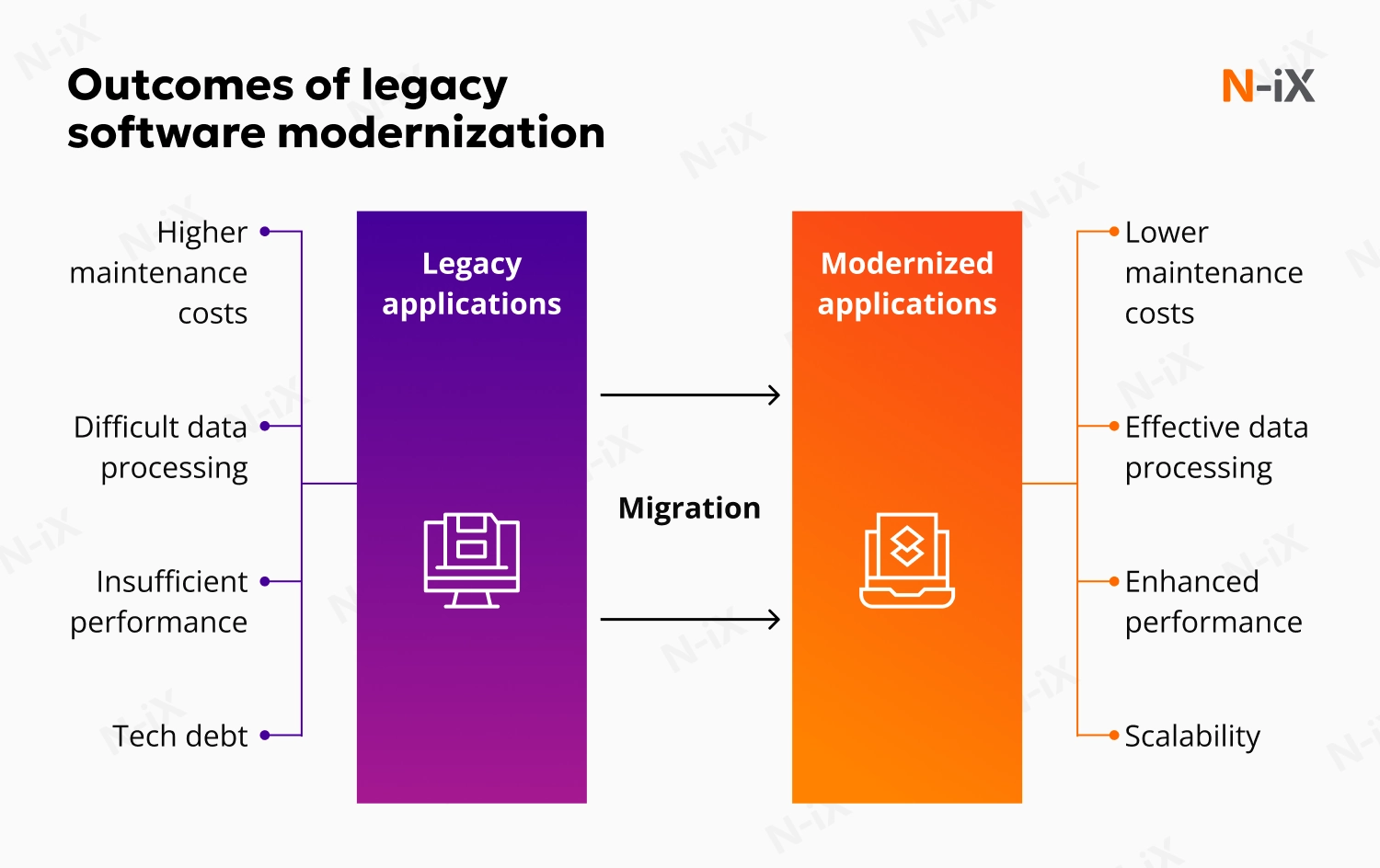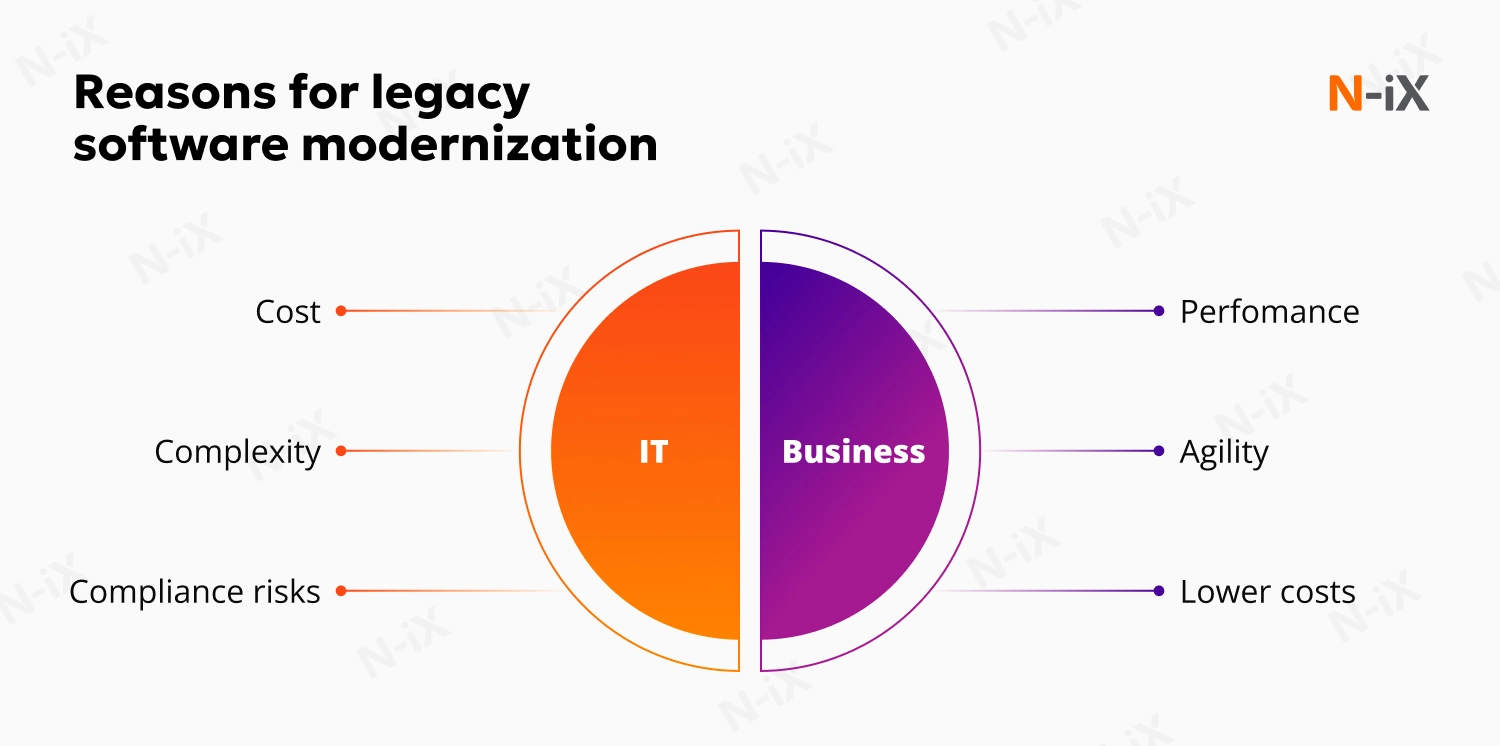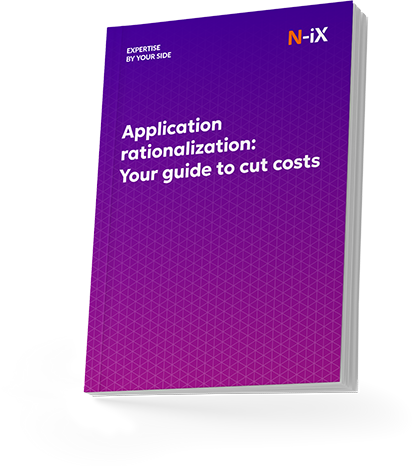As time passes by, any system becomes outdated. There is no avoiding that, and the time to rework and modernize your system will come sooner or later. Failure to modernize might result in the increasing cost of software maintenance, poor customer satisfaction, a lack of competitive edge, and security vulnerabilities.
If you are reading this, you have probably thought about legacy software modernization already, and you may wonder whether it is the right time to modernize. Today, we will look at modernizing legacy systems, the signs that point to the system getting outdated, and the ways a reliable software engineering partner can help with legacy application modernization.
What is a legacy system, and how can it undermine your business?
The simplest way to explain legacy software is to say that it is a system that does not perform the way it was designed to. It is not always about the system’s age, it is more about the system’s performance. Sure, technologies get outdated with time, but even a solution implemented yesterday can become a legacy tomorrow if executed poorly. Such a system cannot keep up with your business objectives.
Legacy systems can cause inefficiencies and disruptions within critical business processes, affecting critical operations. You might have already experienced problems with it: such a system drags down the user experience, is hard to support, and cannot handle the increasing amounts of data. You do not benefit from the system, and its flaws already hinder your business performance. That is where legacy software modernization comes in.
Apart from poor performance, outdated systems are quite expensive to maintain. There are several expenditure points that may already drain your budget if you don’t opt for legacy software modernization:
- Maintenance and support. The cost of software maintenance frequently exceeds the cost of development in just five years after the system launch.
- Integration and compliance. Most regulations get updated on a yearly basis, and the inability to meet the requirements posted by regulatory organs may cost you millions in penalties.
- Security. Outdated security protocols are a major concern for most businesses. Data breaches may cost a pretty penny to a business that does not invest in security updates.
- Lost opportunities. Lack of innovation may impact the long-term profitability of your business. Not being able to adjust to evolving market standards (customer demand, safety regulations, quality standards) will result in lost business opportunities.
- Lack of agility and efficiency. Modernization and automation can improve the efficiency of most processes, and in some cases, efficiency growth reaches 50%.
- Brand reputation. Nobody likes outdated software. It lags, it crashes, it looks bad. Poorly performing software may damage your brand reputation.

Running your business on a legacy system becomes more challenging the more you delay legacy software modernization. Some businesses run on legacy systems for years, and their technical debt just keeps growing. So, how do you know when the time draws near to make a run for legacy application software modernization? Let’s see.
Reasons to modernize your existing system
With application re-engineering, businesses can improve efficiency, reduce costs, and enhance customer satisfaction. Moreover, modernization enables businesses to take advantage of new technologies, improve data integrity, and support future growth.
Many organizations continue relying on outdated software systems simply because they have always worked. Until they no longer do. Technology evolves rapidly, and even heavily-invested systems lose relevance over time if left untouched. Modernization becomes not just a strategic move but a necessity. So, let’s take a look at the main reasons why businesses go for legacy software modernization development.
1. Talent scarcity
The growing difficulty of finding skilled professionals to maintain or enhance your existing system is among the common reasons for legacy software modernization. For example, legacy applications built in COBOL, a language dating back to the 1960s, pose significant risks, not due to the technology itself, but because the talent pool is shrinking fast. When experienced developers retire and replacements are scarce, support costs increase, knowledge gaps widen, and business continuity is jeopardized. If your system depends on technologies used only by few experts, it is a strong indicator that modernization can no longer be delayed.
2. Expensive support and maintenance
Legacy systems often come with growing operational overhead. What once cost $100 a day to support may now cost ten times as much due to outdated infrastructure and limited expertise. Aging servers consume more power, require more physical space, and demand constant attention from increasingly scarce and expensive system administrators. As complexity increases and efficiency declines, the cost of simply keeping the system running starts to outweigh its value. At this point, modernization becomes a financially sound and strategically necessary decision.
3. Costly scaling
Outdated systems are not designed to support modern business demands. Scaling them often means higher costs, longer development cycles, and more manual effort. Adding new features can take weeks instead of days, processing larger data volumes requires costly infrastructure expansion, and routine tasks consume excessive developer hours.
In many cases, technical constraints, such as outdated programming languages or unsupported platforms, make it impossible to adopt new features or integrate with modern tools. When a system holds back your ability to grow or innovate, legacy software modernization is no longer optional.

You might also be interested in: Application modernization strategy: Executive’s handbook
Rationalize your apps for better efficiency—get the enterprise guide!


Success!

Don't skip the Discovery Phase: 5-step assessment process
Software product modernization can be costly and time-consuming, but for the reasons discussed above, it has to be done. System evaluation is mandatory for the legacy system modernization process, especially for software running for several years. This process might look rather frightening if you don’t know how to do it right. That is where you might need the assistance of a technology consulting partner that can help you evaluate and prepare your IT infrastructure for the software modernization process.
Here at N-iX, our experts focus on bringing innovation to your business with respect to your budget and needs. However, no software product modernization project could be possible without a prior evaluation of the legacy system. This process allows our experts to identify the weaknesses in your infrastructure and potential risks of running on a legacy system, estimate the severity of these risks, and define the necessary solutions.
Step 1: System assessment
Legacy software modernization developers usually start with the analysis of the problem areas of your IT infrastructure. The following are the most widespread pain points we find in our partners that require software product modernization. Answer the following questions to see whether your system requires modernization:
- Stability and reliability. Does the system guarantee continuous performance, or does your team deal with downtimes on a regular basis?
- Compatibility. Does your system integrate with new software? Is it compatible with other systems within your organization? Can you introduce new devices to the system?
- Maintainability. Is your system easy and cost-efficient to maintain? Does the software vendor who developed your system still support it? Does maintenance provide reliable results?
- Outdated functionality. Do all of your system functions work as intended, or do your teams struggle with constant manual workarounds?
If you have problems in at least one of the areas, legacy software modernization is due.
Step 2: Estimate the severity
We've already established that legacy systems drag serious business costs, and these costs can be both direct and indirect. At this point, we need to put numbers under each of those to see how severe the financial impact of a legacy system is for your business.
- Missed opportunities. What kinds of opportunities are missed during downtimes? How much money do you lose for each such opportunity?
- Cost and the possibility of maintenance. Is there a technology vendor who can support your system? How much does that service cost?
- Wasted time. How much time is wasted fixing bugs? How much money does it cost?
- Customer acquisition/attrition. Does poor user experience influence customer attrition rates?
We need to analyze each problem area and put real numbers in front of each problem. Business owners often don't realize how much money they lose because their system is outdated. The goal of business analysts here is to understand how severe the financial cost of the legacy system is for your business.
Step 3: Gather feedback
To identify and understand the problems on each level, we need to gather feedback from both internal and external users. We want to know whether the outdated processes within your infrastructure affect the team's performance, and if they do, we need to know exactly in what way. Getting feedback from a sufficient number of users will help us see what works and what does not work.
Step 4: Complete the SWOT analysis
SWOT analysis is used widely to analyze the performance of systems and their impact on the business.
- Strengths. What works well in your system, which of its aspects are satisfactory, and what parts of the workflow do your users enjoy? Knowing this will help you avoid redundant reworks. As they say, don't fix what isn't broken.
- Weaknesses. What are the main problems with your system? We need to know what aspects of the system's performance cause the most problems for the users. This knowledge will allow us to focus on the problem areas first. The software modernization process takes time, so we will first focus on fixes that would make the lives of your users easier.
- Opportunities. Can any of the existing solutions be improved with minimal effort? This, of course, does not include cutting corners, but some parts of the system can be revitalized with just a couple of twitches. If there's a chance to fix something quickly without compromising the quality, we must take it.
- Threats. What happens if you fail to innovate? Will you lose clients? Will you fall behind the competition? All of these threats need to be specified and addressed accordingly.
Step 5: Define your options and make an informed decision
Now that we have built a precise understanding of your system's flaws, we can move to pick the options for software product modernization. It is paramount to choose a set of solutions that match your specifics, as your business most likely requires a unique solution to address its unique needs.
Select the right approach and a reliable partner for software modernization
Your business and your system have their unique features, so your modernization journey will also be unique. Modern technologies can enhance functionality and maintain compliance with regulations like GDPR and CCPA. Depending on your particular case, modernization might include a number of different steps. But in most cases, you will need to go through the following essential stages of legacy software modernization development.
1. Find a reliable team
Finding skilled legacy software modernization developers is the essential step for any business that lacks the talent for such a project or wants to allocate its resources to other projects. This is mostly relevant for non-IT businesses that have limited technical expertise on board. Finding a reliable software partner might prove to be a challenge in its own right, but you need to be sure of the technical skills of the people you partner with for legacy modernization. Ranking websites such as Clutch may help you narrow down the search list. Then, you can proceed to contact potential vendors and select the right partner for the job.
2. Map a modernization timeline
Legacy software modernization development cannot take five years because, by the time you finish, the system will require modernization all anew. That is why the modernization timeline must be realistic and as swift as possible at the same time. N-iX experts will make sure to select an approach that guarantees the required results fast without cutting corners.
3. Start small and test with a focus group
Modernization can begin on a small scale. You can start to rework certain features of your IT infrastructure or replace them with new ones. Our team can roll out and test new features on a limited scale. You will observe the changes in a smaller focus group, see whether the new solutions work or not, and then decide whether the modernization works the way you have envisioned. That way, you can gradually improve the performance of your system, getting rid of problematic areas and enriching your system with innovative functionality.
4. Scale
As the new features add up, you will begin to see changes in your system’s outlook. The scale of modernization will grow, but this must happen in accordance with the predefined plan. You can implement the new features on a small scale, in one of your facilities or departments. Upon observing the results and evaluating the efficiency of the changes, you can scale the modernization up to all of your departments and facilities to increase their efficiency as well.
Our engineering excellence experts will map out the modernization strategy to make sure all the changes occur in the right order. A structured approach to legacy modernization software will decrease the discomfort for your teams and produce gradual and effective changes for your infrastructure.
5. Document all the changes
We will need to maintain all of your data and documentation regarding the legacy system and its modernization. This information will be vital for continuous business performance, and we have to map out the required documentation and find reliable and secure storage for it.
The modernization process is unique for every business as each faces its own set of challenges. Here at N-iX, we work with clients across many industries and have experience in legacy software modernization in different business verticals. Software product modernization services by N-iX have proven to produce a timely and positive impact on leading businesses and large enterprises.
Bonus tip: Use generative AI to assist you
GenAI is emerging as a powerful enabler in the modernization, helping businesses reduce risk, speed up delivery, and improve decision-making. Here are some of the main generative AI use cases in the field.
Automated code analysis and refactoring
GenAI can analyze large, undocumented legacy codebases to identify outdated components, detect security vulnerabilities, and suggest improvements. It can even assist in translating legacy code into modern programming languages, also replatforming efforts and reducing manual overhead.
AI-generated documentation and system mapping
Many legacy systems suffer from a lack of up-to-date documentation. GenAI can auto-generate technical documentation, visualize system architecture, and suggest modular breakdowns which is essential for understanding system complexity and planning the modernization path.
Enhanced testing and CI/CD optimization
Integrated into DevOps workflows, GenAI can automatically generate unit and integration tests, identify gaps in test coverage, and recommend performance enhancements. It also helps optimize CI/CD pipelines to support faster, more reliable deployments.
To discover more applications, go to generative AI in application modernization
By embedding GenAI into the modernization process, organizations can significantly reduce technical debt, shorten timelines, and improve overall software quality. For enterprises with complex, decades-old systems, GenAI provides a strategic edge in delivering scalable, future-ready solutions.
Need help with finding a reliable vendor? Here are the top 15 application modernization companies
How industry leaders modernize their software through reliable tech partnerships: Featured success stories
Let us take a look at how leading businesses benefit from timely and swift software modernization. Outdated technology often leads to slower performance, restricted functionalities, and increased susceptibility to security threats, making modernization crucial. Here are two select cases of modernization services from N-iX portfolio:
Software modernization for a European retail giant
The client decided to partner with N-iX for the digital transformation journey to redefine and automate some of the internal processes and systems. One of such projects was a legacy promotion management system. The client required a new application that would help in the creation of a unified end-to-end promotion process with all the necessary features attached to it. The client also required a new web application that would automate the proposal management system to cut manual tasks.
The solution offered and implemented by N-iX was to design the architecture for promotion and proposal management systems. Our team then replaced the multiple legacy apps used by the client with a unified and convenient promotion management system. We worked together with the client's QA office and implemented the custom QA automation process to improve the quality of the application. Additionally, our experts have set up the CI/CD pipeline along with the following results:
- Development of a promotion management system that simplifies and speeds up the creation and management of promotions;
- The modernization of a scalable system that can withstand any massive high-load events, such as Black Friday;
- Integration of the new system with more than 40 services that align our development with the client's internal processes.
Legacy logistics platform modernization for a global Tier 1 manufacturer
The client used a legacy logistics platform that did not meet the company's expectations and could not be scaled according to the business' growing needs. Despite the client wanting to refactor the legacy platform, there were no legacy software modernization developers in-house with the right expertise to conduct the migration to microservices and redevelop the existing computer vision solution. The client, thus, partnered with the N-iX team to modernize the logistics platform using AI and then scale it across their global facilities.
Business value:
- Development of a complex yet comprehensive logistics management system that combines the capabilities of Big Data, IoT, AT, and ERP.
- Design of a multiplatform mobile app that utilizes the capabilities of computer vision, NLP, and OCR for convenient document processing.
- Modernization of the legacy platform and introduced microservice architecture and cloud-native infrastructure.
Wrapping up
Let us return to the benefits of software modernization and see what you get from it. Naturally, the benefits of software product modernization services would reveal themselves depending on what prerequisites you start off with. The goal of modernization is to solve ongoing problems and give your business a fighting chance in the ever-fiercer competition in the market.
- Reduce costs and gain higher ROI. Modernized software might be a considerable investment, but it is necessary for the long-term cost efficiency of your business. In some cases, businesses double their efficiency by switching to new software and generating enough ROI to cover the cost of software modernization services and more.
- Improve customer satisfaction. Improve your brand image and give your customers a better experience. This will boost customer retention and acquisition rates.
- Outdo the competition. Innovate and evolve faster and outdo your competitors who fail to modernize.
- Strengthen security. Enhance the security of your IT infrastructure, prevent hacking incidents, have a backup strategy, and have control over data access. All of that is possible thanks to modern security solutions.
The benefits of modernizing the legacy software with N-iX
To achieve the objectives of software modernization, you will need a partner with relevant experience, market insights, industry expertise, and a sufficient talent pool. N-iX offers you:
- 23 years of experience in custom software development and a talent pool of over 2,400 experts specializing in different technology domains.
- Expertise across industry sectors like manufacturing, retail, logistics and supply chain, fintech, healthcare, and more.
- Global presence across 25 locations in Europe, India, and the Americas to supply your needs for innovation and software modernization services from a convenient destination.
- A network of technology partnerships with the world's leading companies. N-iX is a Microsoft Solutions Partner, AWS Advanced Consulting Partner, and Google Cloud Platform Partner.
- Technology office for identification of areas for improvement, detailed assessment, and delivery of legacy software modernization services in accordance with the industry's highest standards.
Have a question?
Speak to an expert





